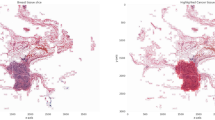Abstract
Invasive ductal carcinoma (IDC) is the type of breast cancer that occurs most frequently. IDC detection is a laborious process and important task. Furthermore, accurate IDC detection is necessary to provide patients with appropriate medical care. Deep learning technique is far more reliable in these kinds of medical scenarios. This study proposes a deep learning model for identifying IDC in breast cancer histopathology images as a tumor is malignant or benign. Residual Network (ResNet) is a component of our deep learning model. Extract the similar features and train to identify future images; this residual network is given tagged BH image data. As a result, it can recognize the presence of IDC in images of breast tissue lesions. The proposed model produces higher accuracy than the existing models.
Access this chapter
Tax calculation will be finalised at checkout
Purchases are for personal use only
Similar content being viewed by others
References
Siegel, M.: Cancer statistics. PubMed-NCBI. J. Clin. 66, 7–30 (2016)
DeSantis, F.: Breast cancer statistics, 2015: convergence of incidence rates between black and white women. J. Clin. 66, 31–42 (2016)
Stathonikos, H.: Going fully digital: perspective of a Dutch academic pathology lab. J. Pathol. Inform. 4 (2013)
Janowczyk, M.: Deep learning for digital pathology image analysis: a comprehensive tutorial with selected use cases. J. Pathol. Inform. 7 (2016)
Celik, Y.: Automated invasive ductal carcinoma detection based using deep transfer learning with whole-slide images. Pattern Recogn. Lett. 133, 232–239 (2020)
Oberoi et al.: Magnetic resonance imaging of breast masses: comparison with mammography. J. Radiol. Imaging 15, 381–387 (2005)
Rejani, I.A.: Early detection of breast cancer using SVM classifier technique. Int. J. Comput. Sci. Eng. 1(3), 127–130 (2009)
Dai, B., Chen, R.-C.: Using random forest algorithm for breast cancer diagnosis. In: International Symposium on Computer, Consumer and Control (IS3C) (2018)
Chhatwal, J., Alagoz, O.: A logistic regression model based on the national mammography database format to aid breast cancer diagnosis. AJR Am. J. Roentgenol. 192(4), 1117–1127 (2009)
Naji, M.A.: Machine learning algorithms for breast cancer prediction and diagnosis. Procedia Comput. Sci. 191, 487–492 (2021)
Abdelrahman, L., Al Ghamdi, M.: Convolutional neural networks for breast cancer detection in mammography: a survey. Comput. Biol. Med. 131 (2021)
Cruz-Roa, A., Basavanhally, A.: Automatic detection of invasive ductal carcinoma in whole slide images with Convolutional Neural Networks. In: Proceedings of SPIE—The International Society for Optical Engineering (2014)
Mridha, M.F., Hamid, M.A.: A comprehensive survey on deep-learning-based breast cancer diagnosis. Cancers (Basel) 13(23), 6116 (2021)
Al-Haija, Q.A., Manasra, G.: Development of breast cancer detection model using transfer learning of residual neural network ResNet-50. Am. J. Sci. Eng. 1(3), 30–39(10) (2020)
He, K.: Deep residual learning for image recognition. Comput. Vis. Pattern Recognit. (2015)
Sounderajah, V., Aggarwal, R.: Diagnostic accuracy of deep learning in medical imaging: a systematic review and meta-analysis. NPI Digit. Med. 65 (2021)
https://www.kaggle.com/datasets/paultimothymooney/breast-histopathology-images
Author information
Authors and Affiliations
Corresponding author
Editor information
Editors and Affiliations
Rights and permissions
Copyright information
© 2023 The Author(s), under exclusive license to Springer Nature Singapore Pte Ltd.
About this paper
Cite this paper
Aditya, K.V., Leelavathy, N., Sujatha, B., Tamilkodi, R., Sattibabu, D. (2023). Deep Learning Framework for the Detection of Invasive Ductal Carcinoma. In: Bhateja, V., Carroll, F., Tavares, J.M.R.S., Sengar, S.S., Peer, P. (eds) Intelligent Data Engineering and Analytics. FICTA 2023. Smart Innovation, Systems and Technologies, vol 371. Springer, Singapore. https://doi.org/10.1007/978-981-99-6706-3_26
Download citation
DOI: https://doi.org/10.1007/978-981-99-6706-3_26
Published:
Publisher Name: Springer, Singapore
Print ISBN: 978-981-99-6705-6
Online ISBN: 978-981-99-6706-3
eBook Packages: Intelligent Technologies and RoboticsIntelligent Technologies and Robotics (R0)




